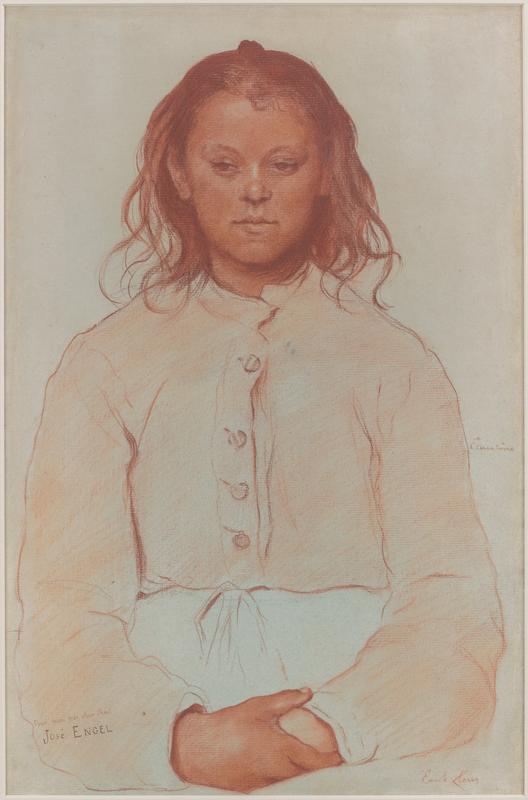
55. Emile Claus, Ernestine
| Artist | Emile Claus, Belgian, Vive-Saint-Eloi 1849–Astene 1924 |
| Title, Date | Ernestine, 1880s |
| Medium | Red chalk and red wash |
| Dimensions | 18 9/16 × 12 3/16 in. (47.2 × 31 cm) |
| Inscriptions + Marks | Lower right: Emile Claus | Middle right: Ernestine | Lower left in black ink: Pour mon très cher ami José ENGEL |
| Provenance | [Mathieu Néouze, Paris, until 2014; to Weisberg]; Yvonne and Gabriel Weisberg, Minneapolis |
| Exhibition History | "Reflections on Reality: Drawings and Paintings from the Weisberg Collection," Mia, 2022–23 |
| References | "Oeuvres sur papier 1860–1930" (exh. cat.), Mathieu Néouze, Paris (March 2014), no. 8, ill. |
| Credit Line | Promised gift of Gabriel P. and Yvonne M.L. Weisberg, Minneapolis |
Emile Claus’s parents, who made only a modest living, were loath to have their sixteenth child become an artist. No doubt to convince them that no other profession would do, Claus tried working as a “pastrycook, railway watchman, [and] a linen draper’s assistant”1 before leaving the Flemish countryside for Antwerp, Belgium, to study art. Eventually, he became one of the premier naturalist painters in Belgium, even winning a gold medal at the 1900 Exposition Universelle in Paris.
After his studies at the Koninklijke Academie voor Schone Kunsten (Royal Academy of Fine Arts) in Antwerp, Claus remained in the city and taught drawing for a time in well-to-do households. In the 1870s he began exhibiting his work locally, as well as in Ghent, Brussels, Liège, and Munich. Then, in 1882 or 1883, he started to orient himself away from the urban scene of Antwerp. He made the first of many visits to the riverside village of Astene, a few miles southwest of Ghent, where he painted the locals and their surroundings. His work resembled that of French naturalist painters, such as Jules Bastien Lepage, Jules Alexis Muenier, or Alfred Roll. Claus received critical praise and began to make significant sales to the Koninklijk Museum voor Schone Kunsten Antwerpen (Royal Museum of Fine Arts Antwerp) and the Belgian royal family. In 1886 he made Astene his principal residence. His success enabled him to spend winters in Paris, where he later developed a more avant-garde impressionistic style of painting featuring bright light and broken color known as Luminism.
The present drawing dates from the mid-1880s, when Claus was newly enamored of rural Astene and establishing himself as a naturalist. He produced numerous landscape drawings and detailed studies of people working and playing in the countryside. Less common were direct portraits, such as this red chalk and wash study of a girl named Ernestine, whose identity is otherwise unknown. Her blouse and apron tell us that she is an agricultural worker of humble means. Her ruddy face and hands suggest long days of work out in the elements. The girl’s uncombed hair grazes her shoulders, and she averts her gaze while seeming to await the result of Claus’s labors. The meticulous modeling of her face and right hand, coupled with the summary treatment of her clothing, gives her a forceful presence.
Claus affectionately dedicated the drawing to his friend José Engel (José Louis Engel-Garry, 1868–1937), a French painter whose works were close to Claus’s later style. The difference between the red chalk signature and the black ink dedication suggests that time had passed before he presented the drawing to his friend.
GPW
Notes
Wynford Dewhurst, Impressionist Painting, Its Genesis and Development (London: George Newnes, 1904), p. 79. ↩︎